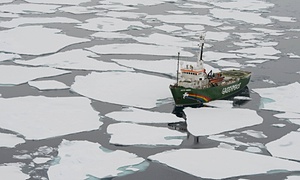The Greenpeace boat on which John Vidal sailed nears the North Pole in 2012’s summer of record ice loss. Photograph: Daniel Beltra/Greenpeace
Obama’s decision to let Shell go ahead will always be seen as plain wrong
By John Vidal
The Guardian (8/21/15)
The Arctic sea ice starts about three days’ steaming north of Norway’s Svalbard archipelago. Small, sporadic floes grow larger, the great Atlantic swells flatten out, the bitter polar winds are stronger and the utter stillness begins. If you can handle the monotony of the vast ice-scape that unfolds, it is possible to navigate a ship with a strong hull and a good lookout nearly to the north pole at this time of year.
Three years ago, I got to within a few hundred miles, alongside Greenpeace and a group of international ice researchers. We might have pressed on through the thick sea ice that forms and melts every year, but no one, least of all the scientists, expected that year’s record ice loss, and only a fuel shortage and time forced us back.
There is much to see. In about three weeks the Arctic’s seasonal ice will reach its lowest extent for the year and start to regrow. But the US National Snow and Ice Data Center in Boulder, Colorado, is reporting that it is 1.35m sq km below the 1981-2010 average, and well below what it was at this time of year in 2010, 2013 and 2014. That’s nearly 40% below the 1970 average.
There will always be blips, and years when the ice appears to be stable or increasing, but science shows conclusively that over recent time Arctic sea ice is only going in one direction – retreating faster than anyone predicted. Russian and European ore carriers, tankers and freighters are already taking advantage and preparing to follow the northern sea passage across the north of Russia to China – so saving thousands of miles and tonnes of fuel. The elusive Northwest Passage through the Canadian archipelago this year remains clogged with ice, but the way it is going it may be possible to cruise right over the pole in the summer of 2030.
Meanwhile on the other side of the Arctic Ocean, Shell’s small corporate navy is nearing its destination in the Chukchi Sea, north of Alaska. This week the Obama administration granted the world’s second largest oil company final approval to restart its search for Arctic oil, and its platforms will soon begin to drill 2,400 metres deep. The exploration season is short and the dangers great, but after 10 years of trying and $7bn spent hoping to unlock the region’s resources, Shell clearly still believes it can find and exploit a giant new oil field to secure its future for decades.
But whose future? President Obama will visit Alaska on 30 August with the secretary of state, John Kerry, where he will give a major speech to Arctic leaders on climate change and try to justify the administration’s decision to let Shell go back in. He will probably say he is mindful of the dangers of offshore drilling and of climate change, but that oil will be with us for a long time yet, that UN agreements will progressively reduce global emissions and that the transition away from fossil fuels cannot be done overnight. But fine words will not disguise the terrible signal that the US administration is giving the world, nor will it remove the stain that may be left on Obama’s environmental legacy. Here, say his friends – including Hillary Clinton – is Obama caving in to Big Oil, giving a licence to continue business as usual. Here is the US – claiming to be the leader in the fight to reduce emissions – backing the riskiest, least-needed oil in the world while saying that the future is clean energy.
To ask Shell not to drill in the Arctic would be like asking the pope not to pray
Clinton nailed Obama this week: “The Arctic is a unique treasure. Given what we know, it’s not worth the risk of drilling,” she wrote. Others put it more strongly: “It’s perplexing and depressing to hear President Obama say he wants to fix climate change but then approve Arctic drilling. It’s like a doctor diagnosing a patient but then refusing to write a prescription,” said Rebecca Noblin, Alaska director for the Center for Biological Diversity.
Don’t blame Shell. The company was never going to back off or pay heed to public opinion. To ask it not to drill in the Arctic would be like asking the pope not to pray. Drilling and polluting is what Shell does, and its corporate culture – honed in blackspots such as Nigeria and the Alberta tar sands – is still based on the old 19th-century explore-exploit-risk-reward capitalist business model that owes nothing to anything beyond the company. The bigger the challenge, the greater the returns, and the bigger the mess that Shell and oil companies make, the quicker they move on. Even as the price of oil plummets far below what it would cost the company to exploit any Arctic oil, Shell argues that it has no option but to embark on its riskiest, most expensive programme ever, and to court international opprobrium.
But for all the corporate protestations, there is no evidence that Shell has ever worried about emissions or the Arctic. Its bean counters know that any oil the company exploits in the Arctic can never be burned without leading to catastrophic climate change, so they must have cynically devised a business model that accounts for it. Shell is therefore saying: “Stuff the science, stuff the UN and the world’s governments that want to limit temperature rises to 2C, stuff the vulnerable people of the Arctic and Africa, stuff public opinion, stuff precaution and all the alternatives to fossil fuels.”
But the world has changed in the past 30 years, and what worked when there was little knowledge or understanding of climate change and little idea of what happens in the remotest corners of the world no longer applies. Today a worldwide movement of informed consumers has got the climate change message. The company is being targeted as Public Enemy No 1. Having lost the moral and scientific arguments, it must now fear that it has little time before overwhelming opinion forces real change.
Its Arctic foray will change nothing immediately. The sea ice will go on growing and melting, but the melting may be faster over time and the growth slower. The bitter winds will continue to blow off the pole, but Obama’s decision to let Shell go ahead – just months before fellow world leaders meet to forge a new global climate deal – will always be seen as plain wrong.





